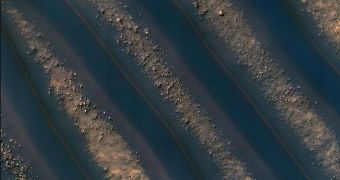Following months of being on safe-mode and off scientific observations, the NASA Mars Reconnaissance Orbiter (MRO) is currently back on its “feet” and is conducting science again. In fact, the latest images released by the team managing the High Resolution Imaging Science Experiment (HiRISE) camera aboard the spacecraft are amazing. They detail a portion of the Red Planet's southern hemisphere. Just West of the giant Hellas impact basin, HiRISE caught on film a peculiar crater, in the region of Noachis Terra. The feature has some remarkable deposits on its bottom, which give it a particular look, experts at the NASA Jet Propulsion Laboratory (JPL) say.
One of the pictures the team released shows sand-dune symmetry inside a crater. Such peculiar features are not uncommon on Mars, where the combined action of lava, flowing liquid water, winds, dry ice and other factors led to the creation of some very interesting structures. For example, in the southernmost parts of the planet, spider-like features in the ground are formed as frozen carbon sublimates directly into gas. Near the north pole, tree-like features were recently imaged, and proven to be formed by the same mechanisms. A number of canyons and shield volcanoes have also been identified by MRO, Mars Odyssey and the European Space Agency's (ESA) Mars Express.
“The dunes here [Noachis Terra] are linear, thought to be due to shifting wind directions. In places, each dune is remarkably similar to adjacent dunes, including a reddish (or dust-colored) band on northeast-facing slopes. Large angular boulders litter the floor between dunes. The most extensive linear dune fields known in the solar system are on Saturn's large moon Titan. Titan has a very different environment and composition, so at meter-scale resolution they probably are very different from Martian dunes,” the JPL team says. The group, based at the California Institute of Technology (Caltech), in Pasadena, manages the MRO for NASA's Science Mission Directorate, at the agency's Headquarters, in Washington DC.
The orbiter resumed its scientific investigations in mid-December, after having been on safe-mode for about five months. The August malfunction is not the only one that was recorded in 2009, the JPL team says. The computers also shut down previously, on February 23, June 3 and August 6, and, since the fourth time this happened, experts had been frantically trying to figure out the root cause. They also attempted to analyze the implications that the glitches had, or might have, on the ship's systems, and how these changes would affect its future operations.
The recently released images of Mars are available here.

 14 DAY TRIAL //
14 DAY TRIAL //